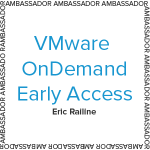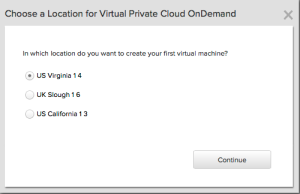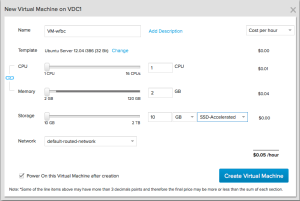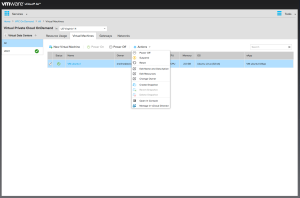Before We Begin
Cloud Computing. The Cloud. Private Cloud. Public Cloud. Hybrid Cloud.Cloud apps. Cloud platforms. Cloud automation. Cloud bursting. Intercloud. Multicloud. Cloudcloudcloudcloudcloudcloudcloudcloud
Ok, enough of that, then.
Private and Public
VMware, as everyone know, is the 800 pound gorilla of infrastructure virtualization, of Infrastructure-as-a-Service, of private cloud. Despite this, and despite VMware’s aggressive pursuit of being more than just the King of Virtualization, it has not historically been focused on, or a leader in, public cloud.
Clearly, Amazon Web Services is the 800 pound – nay, 800 ton – gorilla of public cloud. Why? A number of reasons: early market entry, parent brand recognition, aggressive pricing, sustained investment, and many others. But the biggest reasons are almost certainly the simplest: speed and ease. A relative novice can quickly setup an AWS account and within a few minutes have a virtual machine running on the Internet – all payment taken care of easily via credit card and all charges based on a simple utility usage model. Pay for what you use when you use it, and by how much of it you use. If you use it less, you pay less, and if you don’t use it at all then you don’t pay anything.
If you’re reading this, you’ve undoubtedly used AWS yourself and understand this well. If you haven’t actually gotten your hands wet, you should and you can – just go sign up for the AWS Free Tier for a year and see for yourself: http://aws.amazon.com/free/.
A Step In the Right Direction
VMware’s initial foray into public cloud with vCloud Hybrid Service, now renamed as vCloud Air, was fairly self-explanatory and focused on offering hybrid cloud services where a customer’s private cloud (already running on vSphere) could be expanded and extended into a cloud provider’s infrastructure (in this case VMware’s). Built on vSphere and vCloud Director, it was a powerful platform that leveraged a company’s existing familiarity and trust with VMware’s products to (relatively) easily work with off-prem infrastructure services. It just wasn’t really public cloud , nor were the acquisition & usage models the same: you couldn’t just go sign up with a credit card, and your billing would follow a subscription model for blocks of resources (like your cable TV bill) rather than only actual resources used (like your utility bill).
Now VMware is expanding to provide a true public cloud experience with the development of vCloud Air OnDemand: a pay-as-you-go cloud utility service aimed more squarely at AWS and other public cloud service providers. I was fortunate enough to be selected as an early access participant through the vCloud Air OnDemand Ambassador program, and got to play a bit with it.
Clouds in the Air
In a nutshell: it’s pretty darn good. It certainly looks a lot nicer, cleaner, and more professional than AWS, and it provides a much needed simplified UI in front of vCloud Director (though direct access to the vCD UI is also available throughout the vCloud Air UI for those more comfortable with it or who need to use some of the more advanced features and configurations).
The initial setup is straightforward: login, click on “Virtual Private Cloud OnDemand”, choose your first datacenter to place your workload, and begin provisioning virtual machines.
The wizard for creating your VMs is simple and straight forward, and provides detailed visibility into the costs associated with your configuration choices. You can look at either the per-hour or the per-month cost for the VM, and tweak the setting to your heart’s – and bank account’s – content.
You can also create a VM “from scratch” outside of this simple wizard, which will bounce you out to the vCloud Directory UI instead where you can build new vApps as custom as you like, or import existing vApps and OVFs.
The on-going management dashboard is divided into Resource Usage (i.e. what you’re using & how much it’s costing you), Virtual Machines (the default tab you are taken to), Gateways, and Networks. The majority of your daily VM operations are easily done from here.
Quibbles and Nits
It’s the little things that trip you up: the untied shoelace, the toy in the wrong place, the step that you didn’t see. Despite the polished look of the vCloud Air interface, there were a number of things that proved annoying or made the product more difficult to work with than it needed to be:
- Root passwords: If you use any of the pre-created operating systems in the catalog, the automation will set a new random root password (and provide that password to you in the interface) which you then need to change upon login. Seems reasonable, right? Except that every VM I created this way would never take the new password but would instead return to the login prompt without the change taking effect. Over and over. I tried this with different choices (CentOS 6.3 64-bit, CentOS 6.4 32-bit, Ubuntu Server 12.04 64-bit, Ubuntu Server 12.04 32-bit) across different datacenter locations (US Virginia 14, US California 13) with no difference in behavior. An easy workaround is to simply boot into single user mode, enter the random password, and then manually change using the ‘passwd’ command. Easy, but annoying (and not an issue I’ve encountered with images from AWS, Digital Ocean, etc.).
- Intermittently, the web UI would display incorrectly – usually either calculated fields wouldn’t update automatically or in some cases fields simply wouldn’t display, like this one:
- Help and Support: Choosing the Help option from the upper-right menu takes you to the vCloud Air Documentation Center, which is very good. Choosing the Support Center option takes you to the vCloud Air Support Center – which looks good, but any searches are run against the entire VMware support site and not filtered by (or at least sorted for) vCloud Air. Worse, there’s no option for vCloud Air in the product list on the left for the user to filter their own results.
- Internet access: I’ll go out on a limb & say that in the vast majority of cases, users will need a newly-created VM to be able to access the Internet (for OS updates or software installation if nothing else). For most public clouds, including AWS, the default state of a new VM is Internet-accessible, including inbound access. Yet here it’s not enabled by default, there’s nothing presented in the UI to configure it simply (it’s actually a three step process), and how to do so is semi-buried in the documentation where it is not really clearly described.
In the end, the above are just unnecessary friction for an otherwise slick and powerful product.
Verdict
VMware has done a good job of moving into the utility cloud space with OnDemand. If you’re looking for a cloud service built on the most enterprise-class virtualization products available, run by the company that built those products, and which can allow seamless import/export between the cloud service and your existing private cloud – you want vCloud Air. If you want the power of vCloud Director yet with a simpler interface, you want vCloud Air. And if you want the speed and ease of AWS with the same technology you’re used to in your datacenter, you want vCloud Air OnDemand.
And like AWS, it’s easy to try – just go sign up for an account and get $300 in service credits for the first 90 days!









